Formidilosus
Super Moderator
- Joined
- Oct 22, 2014
- Messages
- 8,172
To show what a full eval looks like, I conducted this on one of the scopes used to proof the rifles. This particular scope has been absolutely trashed for almost a decade. True abuse- hundreds of drops, a massive amount of rounds, etc. The reticle lens is actually cracked from a 15 foot drop . It has never lost zero, and has never failed.
Turrets:
Elevation turret is very low profile and features a “zero lock” button that is pushed in to release the turret to spin. It automatically locks when spun back to zero.
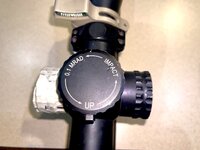
Zero
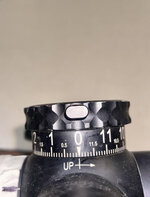
Unlocked

The zero stop is similar to other NF’s, however when combined with the zero lock turret, it’s best to read the instruction manual for the process.
Windage is standard capped and rotation limited.

The elevation turret feel is distinct, and tactile, if a bit rounded. The Zero Lock function is excellent. 12 mils per rev. Locking is positive, and takes direct pressure to unlock. Windage turret clicks are solid and distinct.
Horus H59 reticle:
(Notice the spyder webs or thin squiggly lines around the edges, that’s the cracked glass. It does not effect function, and almost no one notices it even in use until pointed out)
4x
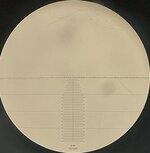
16x
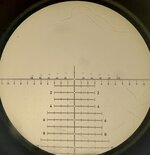
The reticle is one of the first of the common tree reticle designs with a center dot and .2 mil increments in the horizontal and vertical lines, with ticks at .2 mil increments for the tree. It is a good rendition of the type for dedicated long range use, but not for general use.
Parallax:
Knob is very smooth if a bit easy to turn. Depth of focus is decent with 100-infinity being less than a quarter turn. In use it can be set to 300y and basically left for 0-600y in the field.
Initial thoughts:
Both turrets are solid and designed correctly. The Zero Lock is might be the best designed field turret on the market. The windage being capped and rotation limited is excellent. I don’t really care too much about how the turrets feel as long as they aren’t horrible and they work, but this ATACR is very good. As I’ve stated before, I would prefer if it had 10 mils per rev versus 12, but that’s a minor compliant and while not a big deal, no matter how you slice it, your brain can deal with counting up from 5 or 10 mils per rev when you go past the first revolution, rather than 12 or 24 mils.
This scope is marketed as a general purpose long range “tactical” scope that can cross over into hunting use. This particular reticle (H59) is a military or dedicated long range reticle, so while it is definitely not ideal for general hunting, it’s not a mark against this scope- the reticle matches the use. The Mil-C is a better reticle than the H59, but is still quite thin and nearly disappears on low power, low light and broken terrain without illumination.
Zeroing and Return to Zero:
Proofing the rifle and this lot of ammo was done using another scope, the 30 round group extreme spread was 1.37” at 100 yards. Zeroing the 4-16x was accomplished without issue as the scope was previously mounted on this rifle.
Right dot. Top left two shots were after remounting, adjusted down .3, right .2 mils. The group in the bottoms right of the dot is the remaining 8 rounds in the mag. Left dot is the return to zero target. 200 mils dialed between each shot for a total of 2,000 mils. It can be seen from the zero target to the RTZ target that I need to come up .1 mil.
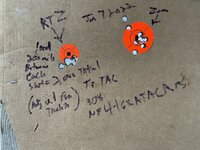
“Tracking”
Next was the live fire “tracking” target. I measured using both the reticle and a spotter to be 7.75 mils between dots. I used 7.8 mils for shooting.

No issues noted. This scope has been tested in a static tracking board and adjusts to less then 1% error at 20 mils.
Drop evaluation:
For an explanation see- Scope Field Eval Explanation and Standards
The “test” consists of three 18” drops on a mat- one left/right/top with a shot to check zero after each drop. Then the exact same thing repeated from 36”. Then three drops on all three sides for nine drops on the last part- 15 drops total. This is not “abuse”. The 18” drops are a joke really. The 36” start showing something. And when a scope make/model consistently goes through the whole thing without losing zero, failures in actual use are almost unheard of.
This one was conducted on packed, semi crusted snow.
It passed without issue as it has for hundreds of drops. Each shot is labeled.
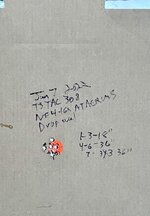
Remember the baseline 30 round extreme spread group was 1.37” with this ammo. The dot is one inch. Every round is within baseline.
Results:
The scope works. It functions and adjusts as it should, it holds zero. I have seen dozens of these scopes, all of them functioned correctly. Being that it passed everything, I will give my subjective views as far as eyebox, image quality, and overall use and feel in the next posts.
Discuss Here
Turrets:
Elevation turret is very low profile and features a “zero lock” button that is pushed in to release the turret to spin. It automatically locks when spun back to zero.

Zero

Unlocked

The zero stop is similar to other NF’s, however when combined with the zero lock turret, it’s best to read the instruction manual for the process.
Windage is standard capped and rotation limited.

The elevation turret feel is distinct, and tactile, if a bit rounded. The Zero Lock function is excellent. 12 mils per rev. Locking is positive, and takes direct pressure to unlock. Windage turret clicks are solid and distinct.
Horus H59 reticle:
(Notice the spyder webs or thin squiggly lines around the edges, that’s the cracked glass. It does not effect function, and almost no one notices it even in use until pointed out)
4x

16x

The reticle is one of the first of the common tree reticle designs with a center dot and .2 mil increments in the horizontal and vertical lines, with ticks at .2 mil increments for the tree. It is a good rendition of the type for dedicated long range use, but not for general use.
Parallax:
Knob is very smooth if a bit easy to turn. Depth of focus is decent with 100-infinity being less than a quarter turn. In use it can be set to 300y and basically left for 0-600y in the field.
Initial thoughts:
Both turrets are solid and designed correctly. The Zero Lock is might be the best designed field turret on the market. The windage being capped and rotation limited is excellent. I don’t really care too much about how the turrets feel as long as they aren’t horrible and they work, but this ATACR is very good. As I’ve stated before, I would prefer if it had 10 mils per rev versus 12, but that’s a minor compliant and while not a big deal, no matter how you slice it, your brain can deal with counting up from 5 or 10 mils per rev when you go past the first revolution, rather than 12 or 24 mils.
This scope is marketed as a general purpose long range “tactical” scope that can cross over into hunting use. This particular reticle (H59) is a military or dedicated long range reticle, so while it is definitely not ideal for general hunting, it’s not a mark against this scope- the reticle matches the use. The Mil-C is a better reticle than the H59, but is still quite thin and nearly disappears on low power, low light and broken terrain without illumination.
Zeroing and Return to Zero:
Proofing the rifle and this lot of ammo was done using another scope, the 30 round group extreme spread was 1.37” at 100 yards. Zeroing the 4-16x was accomplished without issue as the scope was previously mounted on this rifle.
Right dot. Top left two shots were after remounting, adjusted down .3, right .2 mils. The group in the bottoms right of the dot is the remaining 8 rounds in the mag. Left dot is the return to zero target. 200 mils dialed between each shot for a total of 2,000 mils. It can be seen from the zero target to the RTZ target that I need to come up .1 mil.

“Tracking”
Next was the live fire “tracking” target. I measured using both the reticle and a spotter to be 7.75 mils between dots. I used 7.8 mils for shooting.

No issues noted. This scope has been tested in a static tracking board and adjusts to less then 1% error at 20 mils.
Drop evaluation:
For an explanation see- Scope Field Eval Explanation and Standards
The “test” consists of three 18” drops on a mat- one left/right/top with a shot to check zero after each drop. Then the exact same thing repeated from 36”. Then three drops on all three sides for nine drops on the last part- 15 drops total. This is not “abuse”. The 18” drops are a joke really. The 36” start showing something. And when a scope make/model consistently goes through the whole thing without losing zero, failures in actual use are almost unheard of.
This one was conducted on packed, semi crusted snow.
It passed without issue as it has for hundreds of drops. Each shot is labeled.

Remember the baseline 30 round extreme spread group was 1.37” with this ammo. The dot is one inch. Every round is within baseline.
Results:
The scope works. It functions and adjusts as it should, it holds zero. I have seen dozens of these scopes, all of them functioned correctly. Being that it passed everything, I will give my subjective views as far as eyebox, image quality, and overall use and feel in the next posts.
Discuss Here
Last edited by a moderator:
